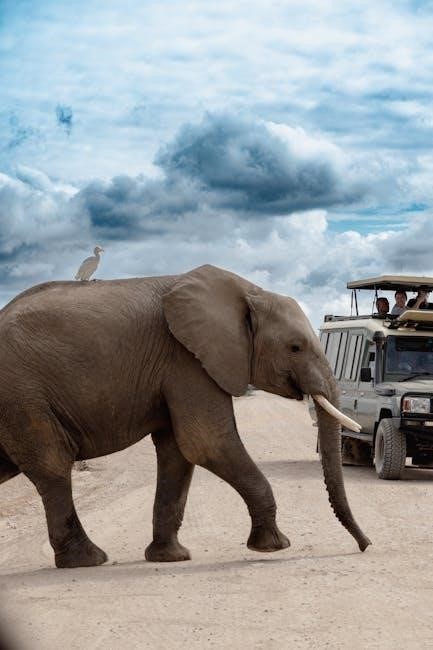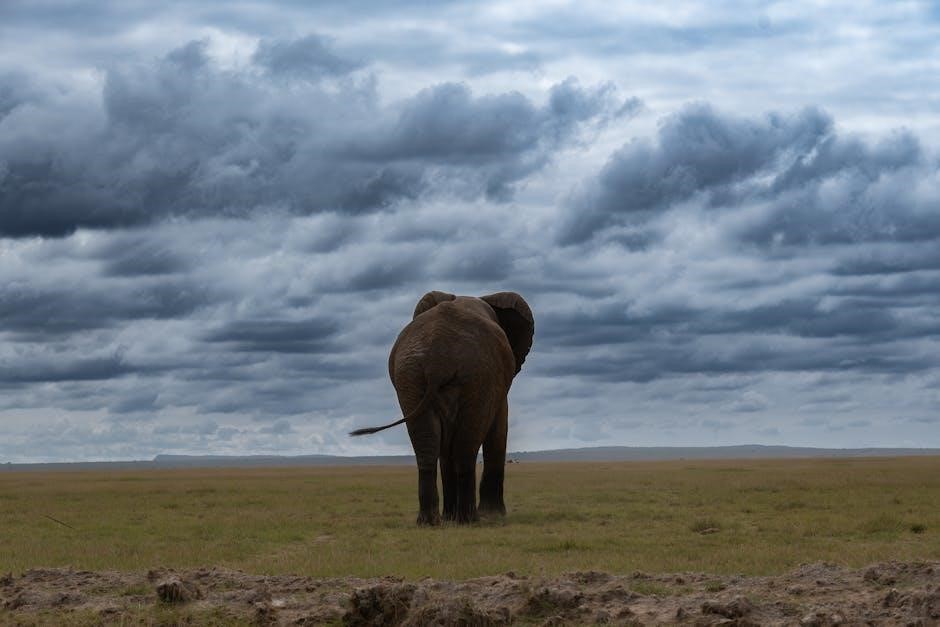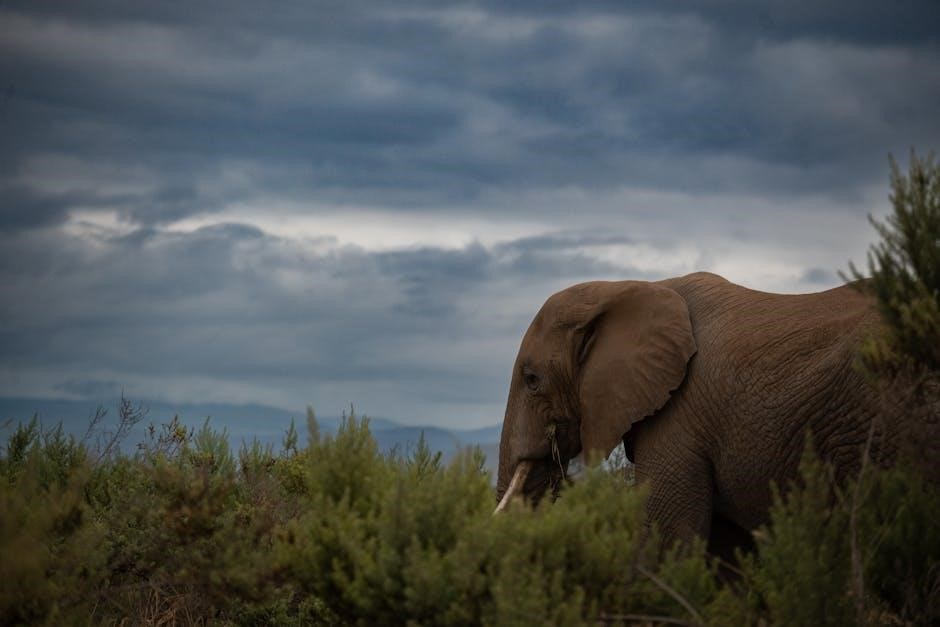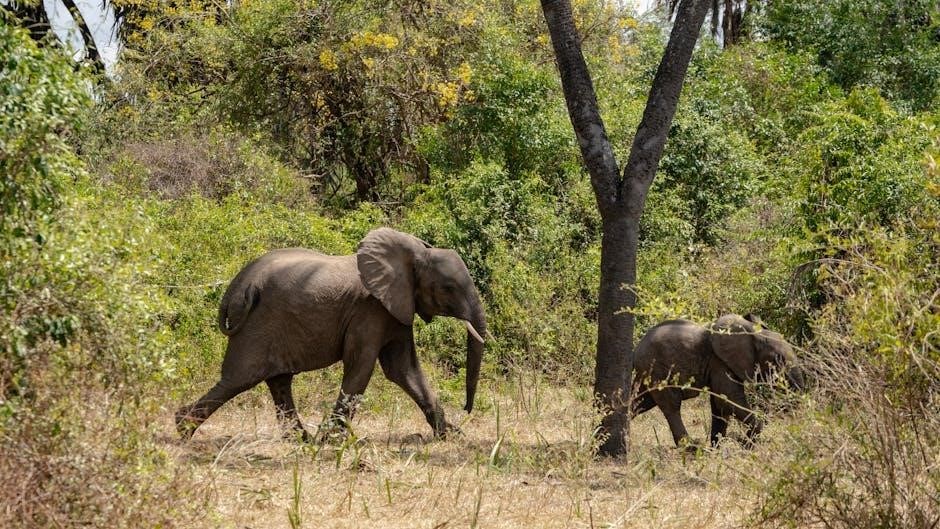George Orwell’s essay Shooting an Elephant is a thought-provoking narrative about a young police officer’s moral dilemma in colonial Burma. The story explores themes of imperialism, peer pressure, and personal conflict, offering a vivid critique of colonialism’s complexities and human nature.

Historical Context
George Orwell’s essay Shooting an Elephant is set in British-ruled Burma during the 1920s, a time of intense colonial tension. Orwell, who served as a sub-divisional police officer in Moulmein, Burma, witnessed firsthand the complexities of colonial rule. The essay reflects the broader historical context of British imperialism in Southeast Asia, where native populations often resented European authority. In Burma, anti-European sentiment was particularly strong, and colonial officers like Orwell were seen as symbols of oppression. The essay captures the atmosphere of petty hostility and resistance that characterized colonial life. Orwell’s experiences in Burma deeply influenced his views on imperialism, shaping his critique of its moral and political implications. The historical backdrop of colonial exploitation and native resistance provides the framework for the narrator’s internal conflict and the events that unfold in the story. By examining this context, readers gain a deeper understanding of the essay’s themes and Orwell’s evolving perspective on colonialism. The essay remains a powerful critique of imperialism and its effects on both the ruled and the rulers.

Themes
The essay explores themes of imperialism and colonialism, highlighting the moral complexities of British rule in Burma. It also delves into moral conflict and peer pressure, as the narrator struggles with personal ethics and societal expectations, revealing the psychological toll of colonial authority.

3.1 Imperialism and Colonialism
George Orwell’s Shooting an Elephant is a powerful critique of imperialism and colonialism, set during British rule in Burma. The narrator, a sub-divisional police officer, represents the oppressive colonial authority, while the Burmese people embody the resentment and resistance against foreign domination. The essay highlights the inherent contradictions of colonialism, where the colonizer is both feared and resented. Orwell portrays the narrator’s internal conflict, as he struggles with the moral implications of his actions, forced to conform to the expectations of colonial rule. The elephant, a symbol of untamed Burma, represents the indigenous resistance that colonial powers sought to suppress. By shooting the elephant, the narrator acquiesces to the pressures of colonial authority, even though he personally opposes the act. This moment of compliance underscores the oppressive nature of imperialism and the loss of individual agency under colonial rule. Through this narrative, Orwell exposes the psychological and moral corruption inherent in colonial systems, offering a scathing critique of British imperialism in Burma.
3.2 Moral Conflict and Peer Pressure
In Shooting an Elephant, George Orwell masterfully illustrates the moral conflict faced by the narrator, driven by peer pressure and societal expectations. The narrator, a British police officer in colonial Burma, is acutely aware of the hostility directed toward him by the local population. When he is called to deal with a rogue elephant, he is initially reluctant to shoot it, recognizing that the situation does not warrant such drastic action. However, the presence of a growing crowd of onlookers compels him to act against his conscience. The pressure to maintain the image of authority and control imposed by colonial rule forces the narrator to prioritize appearances over ethical judgment. This internal struggle highlights the tension between personal morality and the demands of conformity. Orwell’s narrative underscores how peer pressure and societal norms can lead individuals to commit morally questionable actions, even when they privately disagree with them. This theme serves as a broader commentary on the human tendency to succumb to external expectations, often at the expense of personal integrity.
Characters
The narrator, a sub-divisional police officer, is the central character, grappling with moral dilemmas and societal expectations. The elephant, though non-human, symbolizes the colonies’ powerlessness and the destruction caused by imperialism, serving as a silent yet pivotal figure in the narrative.
4.1 The Narrator
The narrator, a British police officer in colonial Burma, is portrayed as a complex figure caught between personal morals and societal pressures. As a representative of the Empire, he feels the weight of expectation to maintain authority. His internal conflict is evident as he struggles with the decision to shoot the elephant, driven less by necessity and more by the fear of appearing weak in front of the native crowd. This dilemma highlights his vulnerability and the moral ambiguity of colonial rule. Orwell’s portrayal of the narrator serves as a critique of imperialism, exposing the psychological toll it takes on individuals forced to uphold an unjust system. The narrator’s reluctant actions reveal the tension between his own beliefs and the demands of his role, making him a deeply human and relatable character in the essay.
4.2 The Elephant
The elephant in George Orwell’s essay serves as both a literal and symbolic figure, embodying the chaos and unpredictability of colonial Burma. Initially tame, the elephant enters a state of “must,” a period of heightened aggression driven by instinct, leading it to destroy property and terrify the local population. Its rampage creates a sense of urgency, forcing the narrator to confront the situation. The elephant’s size and strength symbolize the uncontrollable forces of nature and the futility of human attempts to dominate them. Despite its ferocity, the elephant is also a victim—chained, domesticated, and ultimately doomed by its own instincts and the actions of those around it. Orwell uses the elephant to illustrate the destructive consequences of colonialism, where even the most seemingly powerful entities are subject to exploitation and harm. The elephant’s death, orchestrated to maintain the narrator’s authority, underscores the moral emptiness of imperial power and the absurdity of its enforcement. Through the elephant, Orwell critiques the violence and irrationality inherent in colonial rule, while also evoking a sense of pity for a creature caught in a system beyond its control.
Symbolism

Symbolism in Shooting an Elephant enriches the narrative, with elements representing broader themes. Orwell employs symbols to critique colonialism, exploring moral conflicts and societal pressures. These symbols highlight the complexities of human behavior under oppressive systems.
5.1 The Elephant as a Symbol
The elephant in George Orwell’s essay serves as a powerful symbol, representing both the oppressed and the oppressor. Its uncontrolled rampage through the village mirrors the chaotic and destructive nature of colonialism, while its eventual death symbolizes the inevitable consequences of imperialism. The elephant, once a majestic creature, is reduced to a force of destruction, much like how colonial powers disrupt indigenous societies. Orwell’s reluctance to shoot the elephant but ultimately giving in to societal pressure underscores the moral conflict inherent in colonial rule. The elephant’s death also highlights the futility of colonial authority, as the act of shooting it becomes an empty assertion of power rather than a necessary action. Through this symbolism, Orwell critiques the colonial system, revealing how it dehumanizes both the colonizer and the colonized, trapping them in a cycle of violence and oppression.
5.2 The Rifle
The rifle in Shooting an Elephant is a significant symbol, representing both power and the burden of responsibility. Orwell’s narrator carries the rifle as a tool of authority, yet it also embodies the weight of colonial rule. The rifle is not just a weapon but a symbol of the colonizer’s dominance over the colonized. When the narrator retrieves the rifle, he does so reluctantly, knowing its potential to escalate the situation. The rifle’s presence amplifies the tension, as it signifies the potential for violence and control. However, the narrator’s hesitation to use it reveals his internal conflict about the morality of his actions. The rifle also serves as a catalyst for the crowd’s expectations, pressuring the narrator to act decisively. Ultimately, the rifle symbolizes the destructive power inherent in colonial authority and the moral dilemmas faced by those enforcing it. Through the rifle, Orwell critiques the mechanisms of oppression and the psychological toll they take on both the oppressor and the oppressed.
George Orwell’s Shooting an Elephant is a profound critique of colonialism and the moral complexities it entails. Through the narrator’s reluctant decision to shoot the elephant, Orwell exposes the inherent hypocrisy and destructive nature of imperial power. The essay highlights how colonial rule dehumanizes both the oppressor and the oppressed, trapping them in a cycle of violence and fear. The narrator’s internal conflict—between his desire to do what is right and the pressure to conform to societal expectations—underscores the psychological toll of colonialism. The elephant, as a symbol of Burma’s oppressed people, represents the innocent victims of imperialism. Orwell’s vivid prose and nuanced exploration of human nature make the essay a timeless commentary on the dangers of unchecked power and the loss of moral agency. Ultimately, Shooting an Elephant serves as a powerful indictment of colonialism, urging readers to reflect on the ethical consequences of authority and control.



